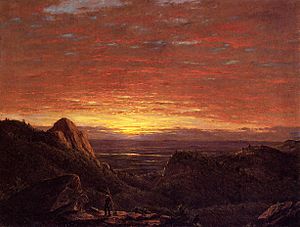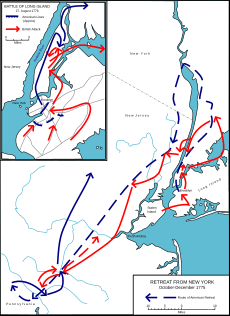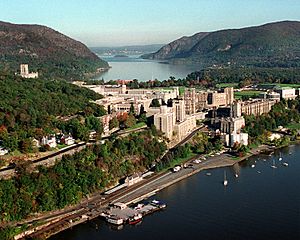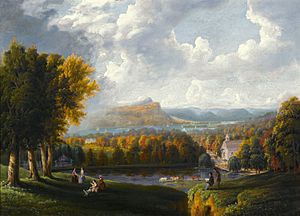History of the Hudson Valley facts for kids
The Hudson Valley is a beautiful area in New York State. It includes the valley of the Hudson River and the towns along it. This region stretches from the cities of Albany and Troy south to Yonkers in Westchester County. Millions of people call the Hudson Valley home, living along the famous Hudson River.
Contents
Early People of the Hudson Valley
Long before Europeans arrived, the Hudson Valley was home to Native American groups. The Algonquins lived along the Hudson River. They had three main groups: the Lenape, the Wappingers, and the Mahicans.
The Lenape lived in the lower part of the Hudson River. They met the explorer Giovanni da Verrazzano and traded with Henry Hudson. They also sold the island of Manhattan. Further north, the Wappingers lived from Manhattan Island up to Poughkeepsie. They lived in villages along the river and traded with both the Lenape and the Mahicans. The Mahicans lived in the northern valley, from Kingston to Lake Champlain. Their main village was near Albany.
These Algonquin groups spoke similar languages, so they could talk to each other easily. They usually lived in peace. However, the Mahicans sometimes had conflicts with the Mohawk Indians from the west. The Mohawks were part of the Iroquois nation.
The Algonquins lived in small groups and villages. One important fort was Navish, located at Croton Point. It overlooked the Hudson River. They lived in houses called Wigwams, which could be round or rectangular. Large families often lived in longhouses that were very long.
In their villages, they grew corn, beans, and squash. They also gathered nuts and berries. For food, they fished in the river for freshwater fish, striped bass, sturgeon, herring, and shad. Oyster beds in the river also provided food. They hunted animals like turkey, deer, and rabbits.
Exploration and New Settlements: 1497 to 1800
Exploring the Hudson River
In 1497, John Cabot sailed along the coast and claimed the land for England. In 1524, Florentine explorer Giovanni da Verrazzano visited New York Bay. He thought it was the mouth of a big river. He sailed into the harbor but did not go up the Hudson River.
A year later, Estevan Gomez, a Portuguese explorer, also visited New York Bay. He was looking for a way to sail through North America to Asia. Maps from that time showed the coast from New Jersey to Rhode Island as "the land of Estevan Gomez."
In 1609, the Dutch East India Company sent English navigator Henry Hudson to find a shortcut to Asia. Hudson sailed his ship up the river that now bears his name. He thought he had found the shortcut when the river widened into Haverstraw Bay. He claimed the land for the Dutch. He sailed as far north as present-day Troy before realizing it was not the shortcut.
Dutch Settlements
After Henry Hudson's journey, the Dutch saw a chance for trade in the region. Explorer Adriaen Block sailed up the lower Hudson River. He found that the fur trade would be very profitable. So, the Dutch started a colony called New Netherland.
The Dutch set up three main trading posts. New Amsterdam was at the mouth of the Hudson River. It later became New York City. Wiltwyck was about halfway up the river. It later became Kingston. Fort Orange was the furthest north. It later became Albany.
These posts were mainly for trading furs. The Dutch traded with the Mahicans, which sometimes caused problems with the Mohawk nation. Native Americans trapped many furs to trade for European goods. This trade eventually reduced the number of animals and made the Native Americans rely on the Dutch for trade.
For about 20 years, the Dutch West India Company controlled all trade. Then, other business people could start their own ventures. New Amsterdam quickly became the most important city. At first, the colony had many single adventurers. But over time, families moved in. The colony also started trading food, tobacco, timber, and even slaves.
In 1647, Peter Stuyvesant became the leader of the colony. He found the colony in trouble due to wars with the English and Native Americans. Stuyvesant stopped illegal trading and expanded the settlements along the Hudson River. However, the British invaded New Netherland through New Amsterdam. The city was not ready for a fight, so Stuyvesant had to surrender. New Amsterdam and the colony were renamed New York, after the Duke of York. The Dutch briefly got New York back but lost it again a few years later. This ended Dutch control over the Hudson River.
British Settlements
Under British rule, the Hudson Valley became a major farming area. Large estates, called manors, were built on the east side of the river. Landlords rented land to farmers. The farmers gave a share of their crops to the landlord and sold the rest. This system kept many farmers at a basic living level. Landlords had a lot of power because they produced so much food. West of the Hudson River, there were smaller farms.
A main crop was grain, which was sent downriver to New York City. From there, it was shipped to Great Britain. Merchants had special permission to grind the grain into flour and export it.
During the French and Indian War in the 1750s, the northern Hudson Valley was a key defense point. It protected the British from French attacks coming from Canada.
The Revolutionary War
The Hudson River was very important during the Revolution. It connected to the Mohawk River, which led to the Great Lakes. Also, it was close to Lake George and Lake Champlain. The British wanted to control this water route from Montreal to New York City. If they did, they could cut off New England, a strong area for the Patriots. This would help them focus on getting support from people loyal to Britain in the South.
Many battles were fought along the river. In 1776, George Washington's Continental Army retreated north to White Plains, New York. The British followed them. Washington decided to fight in White Plains. In October 1776, the British attacked. They broke through the Continental defenses at Chatterton Hill. Washington had to retreat across the Hudson River to New Jersey and Pennsylvania. This retreat was important because Washington saved his army. This led to successful surprise attacks on Trenton, New Jersey and Princeton, New Jersey later that year.
After Washington retreated, New England soldiers had to protect the Hudson Highlands. This was a narrow part of the river. The Continentals built Fort Clinton and Fort Montgomery there. In 1777, Washington expected the British General Howe to sail north to meet another British general. This would seal off the Hudson River. But Howe surprised Washington by sailing south to Philadelphia, the Patriot capital. Washington tried to defend Philadelphia but failed.
Howe left Sir Henry Clinton with a smaller force in New York City. Clinton was allowed to attack the Hudson Valley at any time. On October 5, 1777, Clinton's army sailed up the Hudson River. They attacked the twin forts and looted the village of Peeksill. The Continentals fought hard but were outnumbered. The British took the forts. However, Clinton and his men soon returned to New York City.
The Continentals later built the Great West Point Chain. This huge chain was meant to stop British ships from sailing up the river. It was designed to be lowered for friendly ships. But it was never fully tested and was removed after the war.
Later, Benedict Arnold was in charge of West Point. He secretly worked for the British. He planned to give West Point's plans to British major John André. On September 21, 1780, André sailed up the river to meet Arnold. The next morning, American soldiers fired on André's ship, forcing it to leave. André had to return to New York City by land. He was captured near Tarrytown and later hanged. Arnold then escaped to New York City.
Industrial Growth and the 20th Century
After the Erie Canal was built, the Hudson Valley became a major industrial area. The canal connected the Hudson Valley and New York City to trade with the Midwest. However, in the mid-20th century, many industrial towns started to decline.
New York's first railroad, the Mohawk and Hudson Railroad, opened in 1831. It ran between Albany and Schenectady. This allowed people to avoid the slowest part of the Erie Canal.
Railroads found the Hudson Valley a good place to build tracks. The Troy and Greenbush Railroad opened in 1845. It ran a short distance on the east side of the river. The Hudson River Railroad was built next, connecting to New York City by 1851. In 1866, the Hudson River Bridge opened between Greenbush and Albany. This allowed trains to travel directly between the Hudson River Railroad and the New York Central Railroad. When the Poughkeepsie Bridge opened in 1889, it was the longest single-span bridge in the world.
The New York, West Shore and Buffalo Railway was built along the west side of the Hudson. It was a competitor to the New York Central. It was finished in 1884, and the New York Central bought it the next year.
During the Industrial Revolution, the Hudson River was key for manufacturing. It allowed goods to be easily transported from the interior to the coast. Many factories were built in towns like Poughkeepsie, Newburgh, Kingston, and Hudson. A large General Motors factory was in Sleepy Hollow. The river's connection to the Erie Canal helped factories in the Midwest, like car makers in Detroit, transport their goods.
New technologies like steamboats made transport faster. In 1807, the North River Steamboat (later called Clermont) became the first successful commercial steamboat. It carried passengers between New York City and Albany. By the late 1800s, the Hudson River region was the world's largest brick-making area. About 130 brickyards lined the river, employing 8,000 people. They produced about 1 billion bricks a year, many used to build New York City.
Tourism also became a big industry around 1810. Steamboats made it easy to travel from New York City. Many attractive hotels were built in beautiful settings. People who read novels by James Fenimore Cooper or saw paintings by the Hudson River School were especially drawn to the area.
In 1965, Governor Nelson Rockefeller suggested building the Hudson River Expressway. This highway would run from the Bronx to Beacon. An 8-mile section was built, which is now part of U.S. Route 9. But the rest of the highway was never built due to local opposition.
The Hudson River School of Art

In the early 1800s, stories by Washington Irving made the Hudson Valley famous. It was seen as a mysterious place with old Dutch influences (like in The Legend of Sleepy Hollow). The area is also linked to the Hudson River School. This was a group of American Romantic painters who worked from about 1830 to 1870.
Hudson River School paintings show three main ideas about America in the 1800s: discovery, exploration, and settlement. The paintings also show the American landscape as a peaceful place where people and nature live together. These paintings are known for being realistic and detailed. They often show peaceful farms next to wild nature, which was quickly disappearing from the Hudson Valley.
These artists believed that nature in America was a special sign of God. They were inspired by European painters like Claude Lorrain and J. M. W. Turner. Their love for America's natural beauty was shared by writers like Henry David Thoreau and Ralph Waldo Emerson.
The school is named for its artists, their New York location, and their focus on landscapes, especially the Hudson River. While the paintings looked real, many scenes were actually a mix of different places the artists had seen. The artists would travel to wild places to sketch and remember scenes. Then, they would return to their studios to paint the finished works.
Thomas Cole is seen as the founder of the Hudson River School. In the fall of 1825, he took a steamboat up the Hudson. He hiked into the eastern Catskill Mountains and painted the first landscapes of the area. His work was first reviewed in a newspaper in November 1825. Cole, who was from England, was amazed by the bright autumn colors of the area. His close friend, Asher Durand, also became an important artist in the school. Frederic Edwin Church and Albert Bierstadt were the most successful painters of the group.
The Hudson Valley Today
On October 3, 2009, the Poughkeepsie-Highland Railroad Bridge reopened as the Walkway over the Hudson. It is a pedestrian walkway over the Hudson River. It opened as part of the Hudson River Quadricentennial Celebrations, marking 400 years since Henry Hudson's exploration. It connects to over 25 miles of walking trails.




